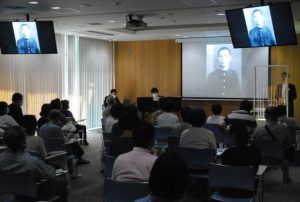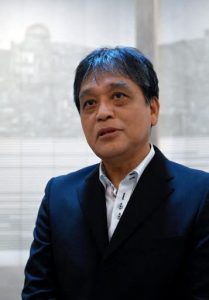Thoughts from Hiroshima: Peace Memorial Hall looks to future after 75th anniversary of atomic bombings
Sep. 7, 2020
by Yuji Yamamoto and Kyoko Niiyama, Staff Writers
The Hiroshima National Peace Memorial Hall for the Atomic Bomb Victims, located in Hiroshima Peace Memorial Park (in the city’s Naka Ward), has come up with several new ideas, such as holding concerts and creating illustrated workbooks, to raise its profile and increase visitor numbers. The memorial hall was established to console the souls of A-bomb victims and pass on A-bombing experiences to next generations through the registration of victims’ photographs and memoir collections. The new efforts arise from a sense of crisis the organization feels about its future after the 75th anniversary of the atomic bombings.
On August 22, the memorial hall held a concert in a seminar room for the first time since its opening in 2002. The concert included songs comprised of music put to poems written by Goro Shikoku (1924-2014), an artist who was a prisoner of war in Siberia and lost his younger brother in the atomic bombing. Mr. Shikoku devoted his life to anti-war and anti-nuclear weapons movements.
The concert was held in conjunction with the hall’s special exhibit “A Tale of Two Brothers Across Time—Hiroshima Artist Goro SHIKOKU and the Diary of Naoto on His Deathbed.” At the exhibit’s opening, Shoji Oseto, deputy director of the memorial hall, remarked, “Being in the same space, I want everyone to deeply consider peace through music.” Yoji Imada, 42, a baritone who was moved upon reading Mr. Shikoku’s poems, sang four solos to a piano accompaniment played by Masanobu Yamashita, 52.
While the seating capacity of the venue was reduced to 50 people to prevent spread of the coronavirus, every available seat was filled. Hitomi Takano, 66, a childcare worker from the city’s Naka Ward who was visiting the memorial hall for the first time, said, “I could sense Mr. Shikoku’s overwhelming grief.” Some listened attentively to the music in tears.
Although the number of visitors to the memorial hall is on the rise, it is still small compared to that of the Hiroshima Peace Memorial Museum, which is also located in Peace Memorial Park. In fiscal 2019, both facilities had to close their doors for about one month due to the coronavirus pandemic and thus were open for 11 months during the course of that year. While the museum had 1,758,000 visitors in 2019, only 379,000 people visited the memorial hall.
This year, the memorial hall has intensified its efforts to draw more visitors. The hall created a pocket-sized workbook for elementary school students this summer that includes hand-drawn cat illustrations created by hall staff. Students will be guided to the Atomic Bomb Survivor Testimonies and Victims’ Information areas as they move through the facilities by responding to questions posed by the cat characters. The workbook can be downloaded from the hall’s website, which has been entirely redesigned for the first time since the hall opened, using a plethora of images and photographs.
All the new efforts have been made to increase the number of visitors, including both local citizens and tourists, to promote and hasten the registration of A-bomb victims, which is the hall’s most important project.
The memorial hall accepts applications from bereaved families to register names and photographs of A-bomb victims. But the number of new registrations has become stagnant. As of the end of fiscal 2019, the hall had 23,789 registrations in total. Considering that, as of August 6 this year, 324,129 names were recorded in the register of the A-bomb Victims, which is stored in the stone chest under the Cenotaph for the A-bomb Victims, the hall registration number is fairly small by comparison.
Isao Hashimoto is curator in charge at the memorial hall. “The registration system is not widely known even among bereaved families. It’s our urgent task to make the system better known and raise people’s awareness,” said Mr. Hashimoto. “If we don’t do it now, it will grow more difficult every year.”
For this reason, the memorial hall started to approach bereaved families and old friends of well-known A-bomb victims who have not been registered. As a result, this fiscal year the hall received an application for Tamiki Hara, a poet best known for his work related to the atomic bombings; Yoko Ota, a writer; Hiroko Kajiyama, an inspiration for the A-bomb Dome preservation movement; and Ichiro Kawamoto, who started the fundraising campaign to erect the Children’s Peace Monument.
The memorial hall also asked local governments in Hiroshima Prefecture for cooperation to ensure that the governments would convey information about the system to families that visit local government offices when they return an Atomic Bomb Survivor’s Certificate after a certificate holder has died.
Collecting memoirs written by survivors and making them available to the public is another of the memorial hall’s main projects. Approximately 147,000 memoirs are stored in the organization’s database. Mr. Hashimoto said, “There are many memoirs here. I hope people come and read them.” Photographs and memoirs are witnesses to the fact that those who experienced the atomic bombing existed in this world. They also inform about the inhumane nature of nuclear weapons. Everyone should all be able to remember and console each of the victims by taking more interest in them and making an effort to recreate their lives.
The national government constructed a memorial hall in each of the two A-bombed cities in accordance with the Atomic Bomb Survivors Relief Law, which was enacted in 1994. The Hiroshima National Peace Memorial Hall for the Atomic Bomb Victims in Hiroshima Peace Memorial Park opened in 2002. The management and operation of this hall is entrusted to the Hiroshima Peace Culture Foundation, an extra-governmental Hiroshima City organization. The other memorial hall in Nagasaki opened the following year.
After the war, A-bomb survivors’ organizations demanded “state compensation” for damages caused by the atomic bombings, but payment of condolence money to the bereaved families and survivors’ pensions was not granted. Instead, the preamble and Article 41 of the relief law stipulate that “the country bears the precious sacrifices of the A-bomb victims in mind.”
The memorial hall registers names and photographs of A-bomb victims, and those with family consent are made available to the public. The hall is also making strong efforts to videotape A-bombing testimonies. On the other hand, information about A-bomb victims that the memorial hall has not been reflected in statistical surveys conducted by the Hiroshima City government starting in 1979 with the aim of keeping an accurate count of victims. Some calls have been made for enhanced cooperation between the organizations.
The Chugoku Shimbun interviewed Masayuki Kubo, 62, director of the Hiroshima National Peace Memorial Hall for the Atomic Bomb Victims, about the role of the facility.
The exhibits of the Hiroshima Peace Memorial Museum focus on actual artifacts that endured the atomic bombing to make sure visitors understand the cruelty of nuclear weapons. On the other hand, our mission at the hall is to collect photographs and memoirs of the victims to “convey the concept of peace with words and emotions.” Now, at this 75th anniversary of the atomic bombing, we feel a sense of crisis about the approach of the last time period in which we will be able to record the real voices of the survivors.
Photographs can tell us how the atomic bombings changed people’s lives. We also hold public readings of memoirs and poetry with the help of volunteers. We can hand down the victims’ wishes for peace to next generations by having as many people as possible visit the memorial hall.
What’s troubling is that many schools that go to the peace museum on school trips are unable to extend their visit to our facility due to a lack of time.
Numbers of overseas tourists, accounting for 40 percent of all visitors, have dropped dramatically due to the coronavirus pandemic. Although the situation has been trying, we will continue to search for new ideas, all the while adhering to our fundamental role as a “hall of remembrance.”
(Originally published on September 7, 2020)
Memorial hall conceives of new ideas—concerts, workbooks—from sense of crisis
The Hiroshima National Peace Memorial Hall for the Atomic Bomb Victims, located in Hiroshima Peace Memorial Park (in the city’s Naka Ward), has come up with several new ideas, such as holding concerts and creating illustrated workbooks, to raise its profile and increase visitor numbers. The memorial hall was established to console the souls of A-bomb victims and pass on A-bombing experiences to next generations through the registration of victims’ photographs and memoir collections. The new efforts arise from a sense of crisis the organization feels about its future after the 75th anniversary of the atomic bombings.
On August 22, the memorial hall held a concert in a seminar room for the first time since its opening in 2002. The concert included songs comprised of music put to poems written by Goro Shikoku (1924-2014), an artist who was a prisoner of war in Siberia and lost his younger brother in the atomic bombing. Mr. Shikoku devoted his life to anti-war and anti-nuclear weapons movements.
The concert was held in conjunction with the hall’s special exhibit “A Tale of Two Brothers Across Time—Hiroshima Artist Goro SHIKOKU and the Diary of Naoto on His Deathbed.” At the exhibit’s opening, Shoji Oseto, deputy director of the memorial hall, remarked, “Being in the same space, I want everyone to deeply consider peace through music.” Yoji Imada, 42, a baritone who was moved upon reading Mr. Shikoku’s poems, sang four solos to a piano accompaniment played by Masanobu Yamashita, 52.
While the seating capacity of the venue was reduced to 50 people to prevent spread of the coronavirus, every available seat was filled. Hitomi Takano, 66, a childcare worker from the city’s Naka Ward who was visiting the memorial hall for the first time, said, “I could sense Mr. Shikoku’s overwhelming grief.” Some listened attentively to the music in tears.
Although the number of visitors to the memorial hall is on the rise, it is still small compared to that of the Hiroshima Peace Memorial Museum, which is also located in Peace Memorial Park. In fiscal 2019, both facilities had to close their doors for about one month due to the coronavirus pandemic and thus were open for 11 months during the course of that year. While the museum had 1,758,000 visitors in 2019, only 379,000 people visited the memorial hall.
This year, the memorial hall has intensified its efforts to draw more visitors. The hall created a pocket-sized workbook for elementary school students this summer that includes hand-drawn cat illustrations created by hall staff. Students will be guided to the Atomic Bomb Survivor Testimonies and Victims’ Information areas as they move through the facilities by responding to questions posed by the cat characters. The workbook can be downloaded from the hall’s website, which has been entirely redesigned for the first time since the hall opened, using a plethora of images and photographs.
All the new efforts have been made to increase the number of visitors, including both local citizens and tourists, to promote and hasten the registration of A-bomb victims, which is the hall’s most important project.
The memorial hall accepts applications from bereaved families to register names and photographs of A-bomb victims. But the number of new registrations has become stagnant. As of the end of fiscal 2019, the hall had 23,789 registrations in total. Considering that, as of August 6 this year, 324,129 names were recorded in the register of the A-bomb Victims, which is stored in the stone chest under the Cenotaph for the A-bomb Victims, the hall registration number is fairly small by comparison.
Isao Hashimoto is curator in charge at the memorial hall. “The registration system is not widely known even among bereaved families. It’s our urgent task to make the system better known and raise people’s awareness,” said Mr. Hashimoto. “If we don’t do it now, it will grow more difficult every year.”
For this reason, the memorial hall started to approach bereaved families and old friends of well-known A-bomb victims who have not been registered. As a result, this fiscal year the hall received an application for Tamiki Hara, a poet best known for his work related to the atomic bombings; Yoko Ota, a writer; Hiroko Kajiyama, an inspiration for the A-bomb Dome preservation movement; and Ichiro Kawamoto, who started the fundraising campaign to erect the Children’s Peace Monument.
The memorial hall also asked local governments in Hiroshima Prefecture for cooperation to ensure that the governments would convey information about the system to families that visit local government offices when they return an Atomic Bomb Survivor’s Certificate after a certificate holder has died.
Collecting memoirs written by survivors and making them available to the public is another of the memorial hall’s main projects. Approximately 147,000 memoirs are stored in the organization’s database. Mr. Hashimoto said, “There are many memoirs here. I hope people come and read them.” Photographs and memoirs are witnesses to the fact that those who experienced the atomic bombing existed in this world. They also inform about the inhumane nature of nuclear weapons. Everyone should all be able to remember and console each of the victims by taking more interest in them and making an effort to recreate their lives.
National memorial halls, built in accordance with Atomic Bomb Survivors Relief Law, collect photographs and memoirs of A-bomb victims
The national government constructed a memorial hall in each of the two A-bombed cities in accordance with the Atomic Bomb Survivors Relief Law, which was enacted in 1994. The Hiroshima National Peace Memorial Hall for the Atomic Bomb Victims in Hiroshima Peace Memorial Park opened in 2002. The management and operation of this hall is entrusted to the Hiroshima Peace Culture Foundation, an extra-governmental Hiroshima City organization. The other memorial hall in Nagasaki opened the following year.
After the war, A-bomb survivors’ organizations demanded “state compensation” for damages caused by the atomic bombings, but payment of condolence money to the bereaved families and survivors’ pensions was not granted. Instead, the preamble and Article 41 of the relief law stipulate that “the country bears the precious sacrifices of the A-bomb victims in mind.”
The memorial hall registers names and photographs of A-bomb victims, and those with family consent are made available to the public. The hall is also making strong efforts to videotape A-bombing testimonies. On the other hand, information about A-bomb victims that the memorial hall has not been reflected in statistical surveys conducted by the Hiroshima City government starting in 1979 with the aim of keeping an accurate count of victims. Some calls have been made for enhanced cooperation between the organizations.
Interview with Masayuki Kubo, director of Hiroshima National Peace Memorial Hall for the Atomic Bomb Victims
The Chugoku Shimbun interviewed Masayuki Kubo, 62, director of the Hiroshima National Peace Memorial Hall for the Atomic Bomb Victims, about the role of the facility.
The exhibits of the Hiroshima Peace Memorial Museum focus on actual artifacts that endured the atomic bombing to make sure visitors understand the cruelty of nuclear weapons. On the other hand, our mission at the hall is to collect photographs and memoirs of the victims to “convey the concept of peace with words and emotions.” Now, at this 75th anniversary of the atomic bombing, we feel a sense of crisis about the approach of the last time period in which we will be able to record the real voices of the survivors.
Photographs can tell us how the atomic bombings changed people’s lives. We also hold public readings of memoirs and poetry with the help of volunteers. We can hand down the victims’ wishes for peace to next generations by having as many people as possible visit the memorial hall.
What’s troubling is that many schools that go to the peace museum on school trips are unable to extend their visit to our facility due to a lack of time.
Numbers of overseas tourists, accounting for 40 percent of all visitors, have dropped dramatically due to the coronavirus pandemic. Although the situation has been trying, we will continue to search for new ideas, all the while adhering to our fundamental role as a “hall of remembrance.”
(Originally published on September 7, 2020)










